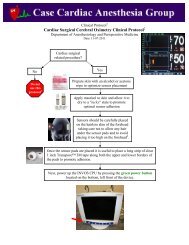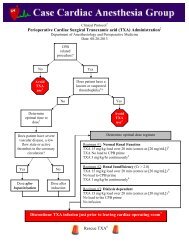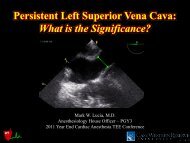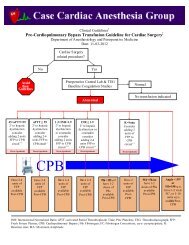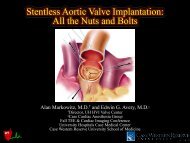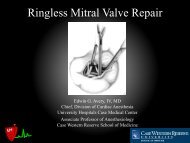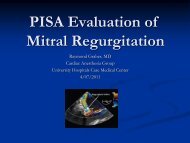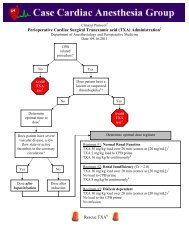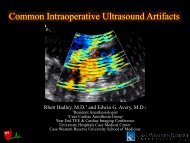LVOT Obstruction: Patients at Risk - Casecag.com
LVOT Obstruction: Patients at Risk - Casecag.com
LVOT Obstruction: Patients at Risk - Casecag.com
You also want an ePaper? Increase the reach of your titles
YUMPU automatically turns print PDFs into web optimized ePapers that Google loves.
OverviewDiscuss the most <strong>com</strong>mon perioper<strong>at</strong>ive clinicalpresent<strong>at</strong>ions of <strong>LVOT</strong> obstruction associ<strong>at</strong>ed withHypertrophic Cardiomyop<strong>at</strong>hy (HCM) and theinterventional options available to tre<strong>at</strong> thisp<strong>at</strong>hologyPresent a clinical case of HCM with <strong>LVOT</strong>obstruction as assessed with intraoper<strong>at</strong>ive TEE
HCM and <strong>LVOT</strong> <strong>Obstruction</strong>HCM variants include:Concentric LVH (RV may also be involved)Asymmetric upper septal hypertrophy (ASH)ASH with or without systolic anterior motion of theanterior mitral leaflet (SAM)SAM with or without mitral regurgit<strong>at</strong>ion (<strong>com</strong>monly aposteriorly directed jet of variable severity)Malposition of the anterior papillary muscleMid-cavitary hypertrophy (with or without a gradient)Apical hypertrophyLV free wall hypertrophy
HCM and <strong>LVOT</strong> <strong>Obstruction</strong>TEE present<strong>at</strong>ion of HCM concentric LVH ± RVH
HCM and <strong>LVOT</strong> <strong>Obstruction</strong>TEE present<strong>at</strong>ion of HCM concentric LVH (PWT or SWT ≥ 11 mm)PWT = 21 mmEnd diastole
HCM and <strong>LVOT</strong> <strong>Obstruction</strong>TEE present<strong>at</strong>ion of ASH SWT:PWT ≥ 1.3
HCM and <strong>LVOT</strong> <strong>Obstruction</strong>TEE present<strong>at</strong>ion of ASH SWT:PWT ≥ 1.3LV long axisSWT = 34 mm(SWT measured perpendicularto LV long axis)Distance to maximal septalthickness from aortic annulusSWT:PWT = 34 / 21 = 1.62End Diastole
HCM and <strong>LVOT</strong> <strong>Obstruction</strong>TEE present<strong>at</strong>ion of HCM ASH with or without SAM
HCM and <strong>LVOT</strong> <strong>Obstruction</strong>TEE present<strong>at</strong>ion of HCM ASH with or without SAM ††Mild posteriorly directed MR
HCM and <strong>LVOT</strong> <strong>Obstruction</strong>TEE present<strong>at</strong>ion of HCM HOCM: <strong>LVOT</strong> gradient (l<strong>at</strong>ent or provoc<strong>at</strong>ive) ††L<strong>at</strong>ent ≥30 mmHg, Provoc<strong>at</strong>ive ≥50 mmHg
HCM and <strong>LVOT</strong> <strong>Obstruction</strong>TEE present<strong>at</strong>ion of HCM HOCM: <strong>LVOT</strong> gradient (l<strong>at</strong>ent or provoc<strong>at</strong>ive) †Peak 92 mmHgMean 53 mmHg†L<strong>at</strong>ent ≥30 mmHg, Provoc<strong>at</strong>ive ≥50 mmHgNote sharper peak associ<strong>at</strong>edwith dynamic obstruction
HCM and <strong>LVOT</strong> <strong>Obstruction</strong>HOCM: <strong>LVOT</strong> gradient (dynamic obstruction)Characteristic“Spike andDome” A-linetracing indynamicobstruction
HCM-<strong>LVOT</strong> <strong>Obstruction</strong>:Tre<strong>at</strong>mentMedical therapy: β-blockers, verapmil, disopyramidePermanent pacemaker (DDD) or ICD implant<strong>at</strong>ionEthanol injection for septal abl<strong>at</strong>ion (1 st septal perfor<strong>at</strong>orcoronary artery)Mitral valve replacement with low profile mechanicalprosthesis (e.g., St. Jude bileaflet tilting disc)Surgical myectomy
HCM-<strong>LVOT</strong> <strong>Obstruction</strong>:Tre<strong>at</strong>mentTEE exam of p<strong>at</strong>ients undergoing septal myectomy should includea <strong>com</strong>plete multiplanar assessment of the aortic valve for evidenceof AI as the surgical approach to the septum may result in damageto the valve
HCM-<strong>LVOT</strong> <strong>Obstruction</strong>:Tre<strong>at</strong>mentMinor AV InjuryPre-MyectomyPost-Myectomy
HCM-<strong>LVOT</strong> <strong>Obstruction</strong>SummaryIn some cases, even aggressive septal myectomy maynot relieve the resting or provoc<strong>at</strong>ive gradient (evenwhen <strong>com</strong>bined with medical therapy).In such cases the implant<strong>at</strong>ion of a low profile mitralmechanical prosthesis can be helpful in relieving thegradient.There is no evidence th<strong>at</strong> ANY therapy alters theprogressive course of this disease.
You’re the Intraoper<strong>at</strong>ive Echocardiography ConsultantEdwin G. Avery, M.D.Chief, Case Cardiac Anesthesia GroupUniversity Hospitals Case Medical Center
Preinduction Hemodynamics
InductionFentanyl + Versed + Cis<strong>at</strong>racuriumSystemic BP: 75/37Pulmonary BP: 82/44Diagnosis? Tre<strong>at</strong>ment?
Phenylephrine + Volume + Ventil<strong>at</strong>ionStable hemodynamics and ready for TEE
ME 4C View
ME 4C Color MV
ME Long Axis View
ME 4C View w/Color
TG Short Axis Mid-pap View
TG Short axis mid-pap View20 mm
ME Long axisSWT:PWT = 30 / 20 = 1.5LV long axisSWT = 30 mm(SWT measured perpendicularto LV long axis)Distance to maximal septalthickness from aortic annulusEnd Diastole
TG LV Long axis
TG Modified LA View
TG Modified Long axis w/color
<strong>LVOT</strong> pre-CPB GradientHCM p<strong>at</strong>ients may have low C.O. secondary to low stroke volumes as a result ofdecreased LV chamber size and non<strong>com</strong>pliance/diastolic dysfunctionPeak 92 mmHgMean 63 mmHgC.O. = 1.7 L/min
Deceler<strong>at</strong>ion time postCPB135 msec (Restrictive < 150 msec)
TDI L<strong>at</strong>eral MV annulus8.6 cm/sec
V p post-CPBV p 39 cm/sec (Restrictive < 45 cm/sec)
IVRT Post-CPBIVRT 200 msec(Restrictive < 60 msec; Delayed Relax<strong>at</strong>ion > 100)
TG SA RV
Membranous septum pre-CPB
ME AV SA w/color
On CPB – Septal Myectomy
ME 4C View post-CPB
ME 4 C view w/color
TG Modified Long axis post-CPB
TG Modified long axis w/color post-CPB
Post-CPB <strong>LVOT</strong> gradientPeak 5 mmHgMean 2 mmHgC.O. = 2.0 L/min
Improved a-line tracingPre-CPBPost-CPB
TG SA RV post-CPB
AV SA post-CPB w/ZOOM
AV LA Zoom post-CPB
The End – Thank YouPlease visit www.casecag.<strong>com</strong> for a copy of this present<strong>at</strong>ion andto view it in video form<strong>at</strong>ClickHere



